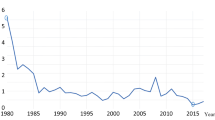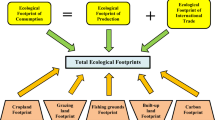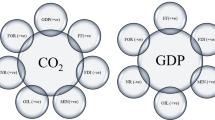Abstract
Many studies have investigated the overall impact of income generated from natural resources on the ecological footprint. However, there is a lack of literature that specifically analyzes the individual contributions of this variable to environmental degradation. To address this gap, this article focuses on examining the relationship between the ecological footprint and income derived from natural gas, oil, and mineral resources. The study utilizes data from 24 countries that have had a significant impact on their ecological footprint between the years 1984 and 2016. By employing advanced cointegration and non-causality techniques for panel data analysis, the research reveals that oil rents have a more pronounced effect on the environmental footprint compared to mineral and natural gas rents. The paper concludes by discussing the important implications of these findings for public policy.

Similar content being viewed by others
Data availability
Attached to this manuscript is the database and programming codes.
Notes
We have omitted coal and forestry revenues due to lack of data.
References
Ahmad M, Jiang P, Majeed A, Umar M, Khan Z, Muhammad S (2020) The dynamic impact of natural resources, technological innovations and economic growth on ecological footprint: an advanced panel data estimation. Res Policy 69:101817
Ahmed Z, Asghar MM, Malik MN, Nawaz K (2020) Moving towards a sustainable environment: the dynamic linkage between natural resources, human capital, urbanization, economic growth, and ecological footprint in China. Res Policy 67:101677
Al-Mulali U, Weng-Wai C, Sheau-Ting L, Mohammed AH (2015) Investigating the environmental Kuznets curve (EKC) hypothesis by utilizing the ecological footprint as an indicator of environmental degradation. Ecol Indic 48:315–323
Alvarado R, Tillaguango B, Dagar V, Ahmad M, Işık C, Méndez P, Toledo E (2021) Ecological footprint, economic complexity and natural resources rents in Latin America: empirical evidence using quantile regressions. J Clean Prod 318:128585
Arellano M, Bond S (1991) Some tests of specification for panel data: Monte Carlo evidence and an application to employment equations. Rev Econ Stud 58(2):277–297
Ben-Salha O, Zmami M (2023) Analyzing the symmetric and asymmetric effects of disaggregate natural resources on the ecological footprint in Saudi Arabia: insights from the dynamic ARDL approach. Environ Sci Pollut Res 30(21):59424–59442
Blundell R, Bond S (1998) Initial conditions and moment restrictions in dynamic panel data models. J Econ 87(1):115–143
Chudik A, Pesaran MH (2015) Common correlated effects estimation of heterogeneous dynamic panel data models with weakly exogenous regressors. J Econ 188(2):393–420
Dumitrescu EI, Hurlin C (2012) Testing for Granger non-causality in heterogeneous panels. Econ Model 29(4):1450–1460
Eberhardt M (2012) Estimating panel time-series models with heterogeneous slopes. Stata J 12(1):61–71
Flores B, Alvarado R (2022) Influencia de la Renta de Recursos Naturales y la Inversión Extranjera en la Degradación Ambiental de Ecuador [Influence of the Rent of Natural Resources and Foreign Investment in the Environmental Degradation of Ecuador] (No. 113736). University Library of Munich, Germany
Global Footprint Network (2019) Data and Methodology. Retrieved from Global Footprint Network. https://www.footprintnetwork.org/resources/data/. Accessed 20 Aug 2023
Grossman G (1995) Economic growth and the environment. Q J Econ 110(2):353–377
Gyamfi BA, Onifade ST, Erdoğan S, Ali EB (2023) Colligating ecological footprint and economic globalization after COP21: insights from agricultural value-added and natural resources rents in the E7 economies. Int J Sustain Dev World Ecol 30(5):500–514
Hassan ST, Baloch MA, Mahmood N, Zhang J (2019a) Linking economic growth and ecological footprint through human capital and biocapacity. Sustain Cities Soc 47:101516
Hassan ST, Xia E, Khan NH, Shah SMA (2019b) Economic growth, natural resources, and ecological footprints: evidence from Pakistan. Environ Sci Pollut Res 26(3):2929–2938
Hussain HI, Haseeb M, Kamarudin F, Dacko-Pikiewicz Z, Szczepańska-Woszczyna K (2021) The role of globalization, economic growth and natural resources on the ecological footprint in Thailand: evidence from nonlinear causal estimations. Processes 9(7):1103
Ikram M, Ferasso M, Sroufe R, Zhang Q (2021) Assessing green technology indicators for cleaner production and sustainable investments in a developing country context. J Clean Prod 322:129090
Jahanger A, Usman M, Murshed M, Mahmood H, Balsalobre-Lorente D (2022) The linkages between natural resources, human capital, globalization, economic growth, financial development, and ecological footprint: the moderating role of technological innovations. Res Policy 76:102569
Kapetanios G, Pesaran MH, Yamagata T (2011) Panels with non-stationary multifactor error structures. J Econom 160(2):326–348
Khan MK, Abbas F, Godil DI, Sharif A, Ahmed Z, Anser MK (2021) Moving towards sustainability: how do natural resources, financial development, and economic growth interact with the ecological footprint in Malaysia? A dynamic ARDL approach. Environ Sci Pollut Res 28(39):55579–55591
Mahmood H, Saqib N (2022) Oil rents, economic growth, and CO2 emissions in 13 OPEC member economies: asymmetry analyses. Front Environ Sci 10:1025756
Makhdum MSA, Usman M, Kousar R, Cifuentes-Faura J, Radulescu M, Balsalobre-Lorente D (2022) How do institutional quality, natural resources, renewable energy, and financial development reduce ecological footprint without hindering economic growth trajectory? Evidence from China. Sustainability 14(21):13910
Nassani AA, Aldakhil AM, Zaman K (2021) Ecological footprints jeopardy for mineral resource extraction: efficient use of energy, financial development, and insurance services to conserve natural resources. Res Policy 74:102271
Nathaniel S, Khan SAR (2020) The nexus between urbanization, renewable energy, trade, and ecological footprint in ASEAN countries. J Clean Prod 272:122709
Onifade ST (2023) Environmental impacts of energy indicators on ecological footprints of oil-exporting African countries: perspectives on fossil resources abundance amidst sustainable development quests. Res Policy 82:103481
Paramati SR, Roca E (2019) Does tourism drive house prices in the OECD economies? Evidence from augmented mean group estimator. Tour Manag 74:392–395
Pesaran MH (2004) General diagnostic tests for cross section dependence in panels. Available at SSRN 572504
Pesaran MH (2007) A simple panel unit root test in the presence of cross-section dependence. J Appl Econ 22(2):265–312
Pesaran MH, Yamagata T (2008) Testing slope homogeneity in large panels. J Econ 142(1):50–93
Phillips PC, Hansen BE (1990) Statistical inference in instrumental variables regression with I (1) processes. Rev Econ Stud 57(1):99–125
Phillips PC, Moon HR (1999) Linear regression limit theory for nonstationary panel data. Econometrica 67(5):1057–1111
The World Bank (2023) Total natural resources rents (% of GDP). Retrieved from https://data.worldbank.org/indicator/NY.GDP.TOTL.RT.ZS. Accessed 29 Aug 2023
Udemba EN (2020) A sustainable study of economic growth and development amidst ecological footprint: new insight from Nigerian Perspective. Sci Total Environ 732:139270
Westerlund J (2007) Testing for error correction in panel data. Oxf Bull Econ Stat 69(6):709–748
Yang X, Anser MK, Yusop Z, Abbas S, Khan MA, Zaman K (2022) Volatility in mineral resource pricing causes ecological footprints: a cloud on the horizon. Res Policy 77:102673
Zaman K (2023) A note on cross-panel data techniques. Latest Dev Econ 1(1):1–7
Zambrano-Monserrate MA, Ruano MA, Ormeño-Candelario V, Sanchez-Loor DA (2020) Global ecological footprint and spatial dependence between countries. J Environ Manag 272:111069
Zia S, Noor MH, Khan MK, Bibi M, Godil DI, Quddoos MU, Anser MK (2021) Striving towards environmental sustainability: how natural resources, human capital, financial development, and economic growth interact with ecological footprint in China. Environ Sci Pollut Res 28(37):52499–52513
Zuo S, Zhu M, Xu Z, Oláh J, Lakner Z (2021) The dynamic impact of natural resource rents, financial development, and technological innovations on environmental quality: empirical evidence from BRI economies. Int J Environ Res Public Health 19(1):130
Acknowledgements
We express our gratitude to the editor and the two anonymous reviewers for their invaluable comments, which significantly contributed to enhancing the quality of this research.
Funding
This research was funded by the Research Center of the Espiritu Santo University in Ecuador.
Author information
Authors and Affiliations
Contributions
M. A. Z-M: conceptualization, methodology, software, formal analysis, writing—original draft, writing—review and editing, supervision. V. O-C: software, formal analysis, writing—original draft.
Corresponding author
Ethics declarations
Ethics approval and consent to participate
Not applicable.
Consent for publication
Not applicable.
Competing interests
The authors declare no competing interests.
Additional information
Publisher’s Note
Springer Nature remains neutral with regard to jurisdictional claims in published maps and institutional affiliations.
Rights and permissions
Springer Nature or its licensor (e.g. a society or other partner) holds exclusive rights to this article under a publishing agreement with the author(s) or other rightsholder(s); author self-archiving of the accepted manuscript version of this article is solely governed by the terms of such publishing agreement and applicable law.
About this article
Cite this article
Zambrano-Monserrate, M.A., Ormeño-Candelario, V. Disaggregated impact of natural resources rents on the ecological footprint: new evidence from more polluting countries. Miner Econ (2023). https://doi.org/10.1007/s13563-023-00407-w
Received:
Accepted:
Published:
DOI: https://doi.org/10.1007/s13563-023-00407-w




